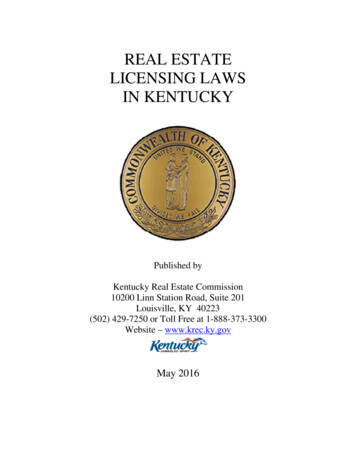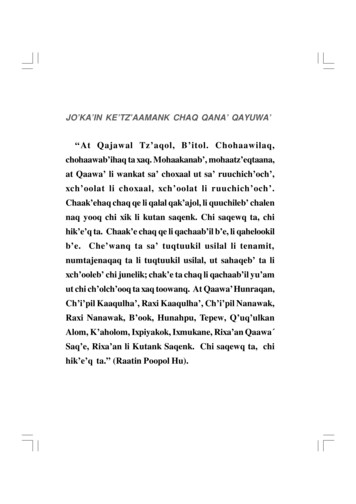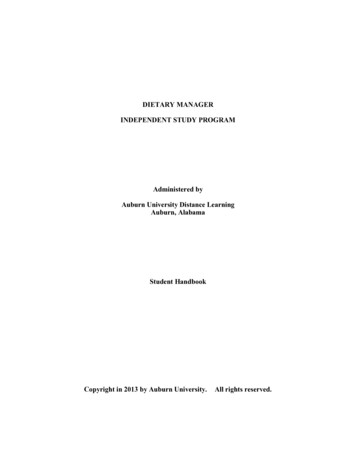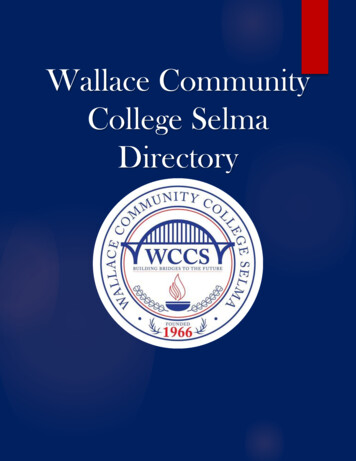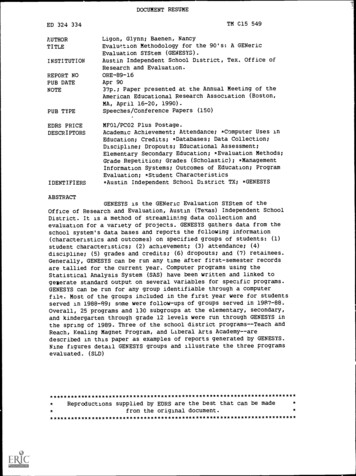
Transcription
DOCUMENT RESUMEED 324 334AUTHORTITLEINSTITUTIONREPORT NOPUB DATENOTEPUB TYPEEDRS PRICEDESCRIPTORSIDENTIFIERSTM C15 549Ligon, Glynn; Baenen, NancyEvaluP.tion Methodology for the 90's: A GENericEvaluation SYStem (GENESYS).Austin Independent School District, Tex. Office ofResearch and Evaluation.ORE-89-16Apr 9037p.; Paper presented at the Annual Meeting of theAmerican Educational Research Association (Boston,MA, April 16-20, 1990).Speeches/Conference Papers (150)MF01/PCO2 Plus Postage.Academic Achievement; Attendance; *Computer Uses inEducation; Credits; *Databases; Data Collection;Discipline; Dropouts; Educational Assessment;Elementary Secondary Education; *Evaluation Methods;Grade Repetition; Grades (Scholastic); *ManagementInformatlon Systems; Outcomes of Education; ProgramEvaluation; *Student Characteristics*Austin Independent School District TX; *GENESYSABSTRACTGENESYS is the GENeric Evaluation SYStem of theOffice of Research and Evaluation, Austin (Texas) Independent SchoolDistrict. It is a method of streamlintng data collection andevaluation for a variety of projects. GENESYS gathers data from theschool system's data bases and reports the following information(characteristics and outcomes) on specified groups of students: (1)student characteristics; (2) achievement; (3) attendance; (4)discipline; (5) grades and credits; (6) dropouts; and (7) retainees.Generally, GENESYS can be run any time after first-semester recordsare tallied for the current year. Computer programs using theStatistical Analysis System (SAS) have been written and linked togegerate standard output on several variables for specific programs.GENESYS can be run for any group identifiable through a computerfile. Most of the groups included in the first year were for studentsserved In 1988-89; some were follow-ups of groups served in 19E17-88.Overall, 25 programs and 130 subgroups at the elementary, secondary,and kindergarten through grade 12 levels were run through GENESYS inthe spring of 1989. Three of the school district programs--Teach andReach, Keeling Magnet Program, and Liberal Arts Academy--aredescribed in this paper as examples of reports generated by GENESYS.Nine figures detail GENESYS groups and illustrate the three programsevaluated. **************************Reproductions supplied by EDRS are the best that can be madefrom the original ******************************
Evaluation Methodology for the 90's:A GENeric Evaluation SYStem(GENESYS)"PERMISSION TO REPRODUCE THISMATERIAL HAS BEEN GRANTED BYU S DEPARTMENT OF EDUCATIONOffice ot Educafionai Research and ImpovernentEDUCATIONAL RESOURCES INFORMATIONCENTER IERICIPU N L / ONi/ms document haS been reproduced as,eceve0 from the Person or ofganaafiOnI-ompnafing .tMinor changes have been made to ,m1Novereproducfion QuahlyTO THE EDUCATIONAL RESOURCESINFORMATION CENTER (ERIC)Roads of v.ew or opafions stated on this doCur ent dO not neCesSaMy fePresent offic.aiOEM pos.fiofi of OMIcYGlynn Ligon, Ph.D.Nancy BaenenAustin Independent School DistrictDepartment of Management InformationAustin, TexasPaper Presented at the 1990 Annual Meeting of theAmerican Educational Research Association,Boston, Massachusetts, April, 1990kr)Session 65.41ORE Report No. 89.162
EXECUTIVE SUMMARY88ORE'S OE es ittvalutt On SYStenrGENE.A Paper Preseatad at Am &wad mitsistig,111111010046111 Rammtrob Mrocistioa, Boston, IWO11144iiiinlotowei,::z.,."43.4tirstiIGENESYS GroupsGENESYS included a widevariety of elementary, secondary, and 1(42 programs in itsfirst year. Students were servedin 1988-89 unless otherwisenoted. Groups included in thisinitial year are listed below.Figure 1 references the fullreports where results arepresented.K-12GENESYS DescriptionGENESYS is a GENeric Evaluation SYStem.GENESYS is a method of streamlining data collection andevaluation through use of computer technology. From yearone in 1973, the Office of Research and Evaluation (ORE)has been challenged to evaluate a multitude of contrastingprogram with limited resources. By standardizing methods and information provided, GENESYS makes it possibleto evaluate a much larger number and variety of programsthan would ordinarily be possible. GENESYS gathers andreports the following standard information on specifiedgroups of students:LEPPALCISMentorElementaryTeach and ReachAIM HighDARE, 1987-88ASSISTSecondaryLiberal Arts AcademyKeeling MagnetScience Academy -- NSFGrantSixth Graders-4988-89,1987-88TAP-1988-89, 1987-88AIP-1988-89, 1987-88Title VIIStudent es/creditsDropoutsRetaineesGENESYS can be run for any group identifiable through acomputer file. Most of the groups included the first yearwere for students served in 1988-89; some were followupsof groups served in 1987-88. A complete listing is shown inthe left-hand column of this page. Three programs areincluded in this AERA paper as examples.Teach and ReachKeating Magnet ProgramLiberal Arts AcademyProject GRADCVAEPEAKRiceRobbinsWINZenithJohnston Computer LabDropoutsPage - I
89.16ACKNONMEDGMENTWe gratefully acknowledge the contributions of DavidWilkinson (Evaluator), Stacy Buffington (Programmer 1Analyst), Letticia Galindo (Evaluation Associate), andRuth Fairchild (Secretwy) to the GENESYS system andthis paper in particular.
80.16Evaluation Methodology for the Ws:A GENeric Evaluation SYStem (GENESYS)Nationwide, many public school evaluation organizations face the challenge ofincreasing demands for evaluation information with limited resources in time and P4Iff.Some of this demand is typically prioritized out when setting an evaluation agendathe year. Particularly problematic are demands for last-minute, instant programevaluation information from sources who cannot be turned down. In this case, staff aretypically taken from other projects to pull together hastily the best information available.In the Austin, Texas, public schools, the Office of Research and Evaluation has developedmethodology to respond to this challengea GENeric Evaluation SYStem calledGENESYS.WHAT IS GENESYS? WHY IS IT NEEDED?GENESYS is the Office of Research and Evaluation's GENeric Evaluation SYStem.GENESYS is a method of stream-lining data collection and evaluation for a wide varietyof projects; it gathers and reports a great deal of information on the characteristics andoutcomes for particular groups of students. Computer programs utilizing the StatisticalAnalysis System (SAS) have been written and linked to generate standard output on anumber of variables for specific programs.GENESYS is the fruition of many years of experience and discussion by AISD's researchand evaluation staff. From year one in 1973, the Office of Research and Evaluation (ORE)has been challenged to evaluate a multitude of contrasting programs with limitedresources -- especially limited time. The idea of a generic evaluation system has beenconceptualized and reconceptualized for years. In 1,989, the shrinkage of staff resources,the growth in information needs, and improvemeLcs in technical capabilities combinedto allow the creation of GENESYS in concrete form. By avoiding more tailored dataanalyses for each program, valuable outcome information can be provided on moreprograms than would ordinarily be possible given limited evaluation resources.GENESYS could not have been implemented in the 1970's. The key element that exists1.,ow which was not present then is a data base containing student, teacher, campus, andother information across a span of years. Additionally, the mid-70's computer wouldhave run for days to complete a set of GENESYS analyses and reports; even today's fastercomputer (3.6 MIPS) works about 30-45 minutes to process the GENESYS computationsfor one program group.HOW DOES GENESYS WORK? WHAT DOES IT PROVIDE?Data-base methodology is used to create a generic evaluation system accessing available,longitudinal data bases using a combination of commercial statistical programs (SAS)and custom computer programming.Page 35
89.16Standard evaluative statistics, i.e., test scores, dropout rates, discipline rates, attendancerates, grade point averages, etc., are summarized in a table as well as being convertedinto a narrative executive summary.Data are accessed from the school system's data bases including grades, attendance,discipline, dropouts, achievement test scores, special education, limited-Englishproficiency (LEP), student demographics, etc. through the IBM 4381 mainframe system.The availability of longitudinal data bases enhances the usefulness of the data.Given a file of those students involved in the program, group, or innovation, GENESYSwill provide outcome information for the following variables:GROUP CHARACTatraTICS: Number served by grade, ethnicity, sex,low income, LEP, overage for grade, special education, gifted and talented;1988 89 ACHIEVEMENr RESULTS BY GRADE; ITBS, TAP, TEAMS and1987-88 to 1988-89 ROSE regression trend information;ATTENDANCE, DISCIPLINE, GRADES/CREDITS: 1987-88 and 1988-89(four semesters);DROPOUTSANDRETAINEES: Counts for dropouts and potentialretainees as of the end of May, 1989, along with a fall, 1989 update on thoseactually retained.Specific definitions for each of these variables are included in Attachment 1. The user isadvise 1 to read and refer to the definitions provided to assure correct interpretation of thedata.For each group, three types of summary sheets are produced:THE GENESYS EVALUATION SUMMARY summarizes inform ation onthe group's overall performance on all variables;niE EXECUTIVE SUMMARY summarizes findings in narrative formand compares the group's data to relevant groups (elementary, middle/junior high, and senior high students).GENESYS DATA BY STUDENT provides a listing of this informationby student (as applicable) to allow a specific review of student attainmentand characteristics (see Attachment 2).WHO CAN BENEFIT FROM AND USE GENESYS7GENESYS is useful to two primary types of audiences.PROGRAM staff, administrators, and members of the Board of Trustees canobtain information on the progress of students involved in particular programsor innovations which would otherwise be unavailable because of scantevaluation resources.Page - 4
89.16EVALUATION staff for various projects can obtain standard informationthrough the GENESYS process for various programs. This provides standarddata to allow comparisons smog projects as well as freeing up staff time to domore sophisticated analyses for areas not covered or not covered in enoughdepth by GENESYS. GENESYS print-outs may reveal trends or interestingfindings that bear delving into more thoroughly as well.WHAT IS NEEDED TO RUN GENIOYS?GENESYS needs a file of student n- aes and identification numbers for the program orgroup which is to be studied before it can be run. Gathering this information is theresponsibility of the program or evaluation staff requesting the information. Names andidentification numbers can be provided as a list, on a computer disk, or as a descriptionof critical location information on computer files (such as a school and grade list or acourse number). Staff must duide whether they want to include all students served forany length of time by a program, those in as of a particular date, or those served a certainlength of time (e.g., over three months). This choice is communicated to ORE with thelist. In addition, staff are asked to provide a brief program description.Generally, GENESYS can be run at any time after first-semester records are in for thecurrent year. Of course, information is available for more variables and is morecomplete at year's end. GENESYS can also be run based on the previous year's data.Attachment 3 provides flow charts for GENESYS.WHAT PROGRAMS ARE INCLUDED IN GENESYS?A list of programs and groups included in GENESYS thus far are shown in Figure 1.Overall, 25 programs and 130 subgroups were run through GENESYS in spring, 1989.Results for these programs are included in the ORE reports referenced. Three samplesare included in this report--one each for an elementary, junior high, and senior highprogram (see Attachment 4). A complete set of results for all groups can be found in theGENESYS Technical Report 1988-89 (ORE Pub. No. 88.46). Particular sections areavailable upon request from ORE.WHAT FUTURE ENHANCEMEMS ARE BEING CONSIDERM?So far dozens of great ideas for enhancements and addkional reports have beendiscussed. A new laser printout layout was completed this fall (1989) for the evaluationsummary (it ie hown in our samples). It is more attractive and easier to understandand use than the original. Some of the most promising ideas for the future are:Executive summaries with comparisons made between groups in addition tobetween a single group and District totals.Statistical significance testEx with probability levels printed between groups andbetween pre- and posttest measures.Page 57
89.18A program summary chart similar to the data-by-student report. This programsummary chart would compare statistics across multiple programs on a singlepage.More "user-friendly" programming so that noncomputer programmers cansubmit their own runs.A staff summary sheet (similar to what we utilize in the Annual PerformanceReport to the Texas Education Agency) and a budget summary based on budgetcodes (similar to the District's budget book).Thus, GENESYS has come a long way but is very much "in process" as a system.FIGURE 1: GENESYS GROUPS- 1988-89PUBLICATIONNUMBERPROGRAM/GROUPREPORT TITLESixth Graders, 1988-89Sixth Graders, 1987-88ORE's Generic Evaluation System:GENESYS 1988-8988.40Kealing MagnetORE's Generic Evaluation System:GENESYS 1988-8988.40Johnston Liberal ArtsAcademyORE's Generic Evaluation System:GENESYS 1988-8988.40Teach and RoachORE's Generic Evaluation System:GENESYS 1988-8988.40Gifted/Talented (AIMHigh) ProgramORE's Generic Evaluation System:GENESYS 1988-8988.40Transitional AcademicProgram (TAP), 1987-88ORE's Generic Evaluation System:GENESYS 1988-8988.40Academic IncentiveProgram (AIP), 1987-38ORE's Generic Evaluation System:GENESYS 1988-8988.40LBJ Science AcademyTargeting New Teachers & Teaching byNovel Techniques: Science Academy of Austin88.30Page 6
80.16FIGURE 1: GENESYS GROUPS-1988-89, continuedPUBLICATIONNUMBERPROGRAM/GROUPREPORT TITLELimited-EnglishProficient (LEP)Watching the Progress of Limited-EnglishProficient(LEP) Students, 1988-8988.39Title VIIRace Against Zme: Secondary Iltle VIIProgram Evaluation, 1988-8988.26Project GRADNew Initiatives in Dropout Prevention:Project GRAD Final Report, 1988-8988.36TAP, 1988-89New Initiatives in Dropout Prevention:Project GRAD rinal Report, 1988-8988.36Drug Abuse ResistanceEducation (DARE), 1987-88Taking Steps Toward Drug-Free Schools88.34AIP, 1988-89New Initiatives in Dropout Prevention:Project GRAD Final Report, 1988-8988.36Communities In Schools (CIS)New Initiatives in Dropout Prevention:Project GRAD Final Report, 1988-8988.36Coordinated VocationalAcademic Education (CVAE)New Initiatives in Dropout Prevention:Project GRAD Final Report, 1988-8988.36Peer Assistance andLeadership (PAL)New Initiatives in Dropout Prevention:Project GRAD Final Report, 1988-8988.36Practical, Effective,Appropriate Knowledge (PEAK)New Initiatives in Dropout Prevention:Project GRAD Final Report, 1988-8988.36Project ASSIST (AssistingSpecial Students in Stress Times)New Initiatives in DropoutProject GRAD Final Report, 1988-8988.36Project MentorNew Initiatives in Dropout Prevention:Project GRAD Final Report, 1988-8988.36Rice Secondary SchoolNew Initiatives in Dropout Prevention:Project GRAD Final Report, 1988-8988.36Robbins Secondary SchoolNew Initiatives in Dropout Prevention:Project GRAD Final Report, 1988-8988.36Work InceNtiveProgram (WIN)New Initiatives in Dropout Prevention:Project GRAD Final Report, 1988-8988.36Zenith ProgramNew Initiatives in Dropout Prevention:Project GRAD Final Report, 1988-888.36Johnston Computer LabNew Initiatives in Dropout Prevention:Project GRAD Final Report, 1988-8, and Chapter 2Formula Evaluation 1988-8988.36in AISD, 1988-89Page . 7988.31
89.16WHAT ARE THE LIMITATIONS OF GENESYS?The GENESYS approach has both positive and negative aspects.On the positive side:GENESYS is objective, statistical, and replicable.The cost/benefit ratio for users is positivo, with only a little effortneeded on their part to obtain a wealth of information. GENESYS isof clear benefit to those who would receive no information at all on aprogram without it (because resources were too limited to evaluateit).The fact that the categories of data and computation methods are thesame for all projects makes comparisons possible that may not havebeen with tailored evaluations.GENESYS can monitor progress of students in a variety of programsand identify those in need of additional follow-up. It can freeevaluation staff from collecting the basics and allow this focusedfollow-up.On the negative side:GENESYS can be faulted for being detached, for not even requiringthe evaluator to see a student personally, or for not verifying thatthere were any real programmatic activities at all.GENESYS may not provide everything a user would want in exactlythe form desired. For example, GENESYS allows a "before, during,and after" look at student attendance and discipline rates forsemester-long programs. However, if a program allows continuousenrollment during a semester, it is not possible at this point to look atseparate student performance before and during program servicewithin that semester.On the technical side, because GENESYS draws on so many largeDistrict computer files and program files as well, it uses largeamounts of computer memory. Therefore, programs must generallybe submitted to be run at night. Because a large number of groups(about 130) were run through GENESYS in 1988-89, it took over amonth for all to be run and finalized.WHAT HAS BEEN LEARNED IN DEVELOPING GENESYS?A great deal was learned in this first year about how to define the variables and make theoutput as easy to understand as possible. Discussions were held several times amongevaluation staff (primarily evaluators and computer programmers) refining informationneeds, discussing formats, and soliciting input on various aspects and problems.Page 840
SaleSystemwide evaluation staff coordinated with various ORE, data processing, and projectstaff to secure project descriptions and files. The computer programmer/analystassigned to GENESYS spent over half of her time this year developing a series ofprograms for GENESYS and refining the system to assure it worked smoothly. Therelative simplicity of the final GENESYS summary sheets hides a complicateddevelopment and production process.Many computer programs were developed in the fall and tested on program files midyear. This revealed "glitches" which were worked out before crucial end-of-the yearruns Some additional glitches were discovered in the year-end runs (mostly in newprograms added after January and in the production procecs) which made GENESYSless "push button" than desired; some have been solved already and others will be workedon this coming year.One facet which took longer than expected was the development of program ffies anddescriptions. Slowdowns were generally caused by the following factors.Deciding who should be included on files was difficult for someevaluation staff who did not "know" these programs as they wouldthose fully evaluated. This was also difficult for program staff notused to thinking in "data" terms. Decisions had to be made onwhether to include those in a program all year, at least a certainlength of tima, or at one point in time. A decision was made earlyon not to standardize this because needs might vary acrossprograms. (For example, dropout prevention programs need totrack all students involved at all in each program.) If a cumulativecount was desired, a method needed to be determined of how teupdate the file and how students added to the program should betreated. For some programs, decisions had to be made whether theprograms should be considered year long or semester long. Somefiles were subdivided into separate files for the subgroups plus a fullyear file.Deciding what source should be used for files also proved interesting(and sometimes frustrating). School staff could provide rosters, butthese could not be updated centrally. Since the goal was to use thecomputer system files as much as possible, the central computerwas generally used whenever possible. Some computer rosters weresent to school staff who were asked to correct any errors directly tothe relevant computer file so that it would be updated for futureruns To the extent this was done, central files are now moreaccurate. To the extent it did not occur, files are not entirelyaccurate. In either case, program staff were put on notice that theDistrict does depend on central files and will do so increasingly inthe future. In the long run, this seems the most productive solution.Some information which seemed quite basic for programdescriptions proved difficult to collect. Staff interpreted the itemsdifferently which meant requesting further information orclarification. Asking how many staff were involved or what thebudget was proved difficult or impossible to determine on somePage 911
89.16programs locally funded or with mixed funding. Program staffwere not used to thinking in those terms, some programs were notisolated by budget codes, and some were simply so complicated thatthey took more than the time avail-able to itermine for a genericevaluation. The process did prove time . Aiming; one way toreduce the time would be simply to accept what was provided thefirst time. However, quality and comparability would suffer. Pastthat, the amount of checking and rechecking which is "reasonable"for a generic evaluation must be defined.Thus, while GENESYS takes little time for a user, it does indeed take considerableresources for evaluation staff to do the initial programming, coordination, and set-upwork. This cost should be reduced as time goes on and formats are accepted. Of course,there are always differences in opinion on formats, and use brings up new needs andquestions. This fall, in fact, GENESYS has already evolved into an improved product.WHAT CAN WE CONCLUDE?Crossing the bridge from dream to reality has taken some work. Overall, the result, forthe iirst year of actual development and implementation, appears to be a very usefulevaluation tool. Many programs have been written and linked into GENESYS. Singlepage charts and narrative summaries have been designed and produced by computer todisplay results quickly and understandably. GENESYS produced a high volume ofinformation about 25 programs and 130 subgroups.GENESYS has both positive and negative aspects. On the positive side, GENESYS isobjective, statistical, and replicable. A great deal of information is generated with a verylow level of effort required by the user. The fact that information is standard allowscomparisons across projects that may not have been possible otherwise. By easilyproviding the basics, evaluation staff can be freed for more sophisticated analyses orprocess evaluation.On the negative side, GENESYS can be seen as detached because process evaluation isnot a part of the system. While a great deal of information is provided, it may not beexactly in the form desired for some programs. On the technical side, GENESYS drawson so many computer files and program files that it uses large amounts of computermemory and time. From an evaluation standpoint, GENESYS is not really designed forcontinuous enrollment programs. Because data is reported on a semester or annualbasis, changes within a semester cannot be detected. It is also difficult to go back in timefor a GENESYS group (unless you have a spring semester program) although it may bepossible in the future.Initial reactions from District administrative staff have varied widely--from delight thata great deal of information was provided on programs, to requests for additionalprograms, to confusion and/or anger about why all programs were rated on the samestandards. Not surprisingly, those with very positive results were happier withGENESYS than those with more neutral or negative results. GENESYS challengesprogram staff, or even members of the public, to study and interpret the informationabout programs more closely themselves; evaluators have insufficient time tosummarize the data further. Some program staff could not understand why descriptiveinformation was includedPage - 10aI
89.16(which, in our view, provided context f9r the type of population served). Others wanted tohave only out4ome information they deemed relevant to their program reported (whichdefeats the purpose of a generic system somewhat).One suggestion from program staff was to add a program response section in which staffcould address the findings and highlight what they believed was most important. Anumber of suggestions have already been made within and outside ORE about additionsor improvementa to the system.An approach like GENESYS can be extremely useful to an evaluation unit as well as toeducation in general. GENESYS provides the means to track the progress of students ina multitude of programs without requiring substantial evaluation resources. This canprovide a great deal of evaluation information to program staff on its own but can alsofree evaluation staff to delve more fully into process evaluation or more P,ophisticatedanalyses. Better programs for students can be the result.To summarize, in the beginning, there was no fot-mal evaluation in education. Thenrequired grant reports, followed by full-blown process and product evaluations, came intobeing. GENESYS represents a new evolution--an approach which can be a totalevaluation or a tool to enhance traditional evaluations by providing basic data simply. Weeagerly await reactions to its usefulness.Page - 1113
89.16ATTACHMENT 1(Page 1 of 3)GENESYS DEFINITIONSEVALUATION SUMMARYPROGRAM MEMBERSHIPDESCRIPTIVE INFORMATIONFor each program included in GENESYS, ORE or program staff definethose to be included (see program descriptions).Most programs orgroups are for students involved in 1988-89.Some (e.g., sixthgraders, DARE, and TAP/AIP) are for groups served in 1987-88.Descriptive information provided for each program includes:NUMBER SERVED:Total served (may I, cumulative, semester, or onepoint in time count).ETHNICITY: Percentage Other (0) (includes White, Asian, andAmerican Indian), Black (B), Hispanic (H).SEX:Percentage female (F) and male (M).LOW INCOME:Percentage eligible for free or reduced-price meals.Percentage identified as limited in English proficiency(regular or special education) and served in bilingual, English-asa-Second Language (ESL), or alternative programs as of the end ofthe year (or whenever GENESYS was run). Note: Some students"exit" or leave LEP status each May once English proficiency isattained.LEP:OVERAGE FOR GRADE:Percentage older than expected for the grade by1st graders 7 orone or more years (as of September 1). Example:more on September 1.SPECIAL EDUCATION:any type.Percentage of students in special education ofGIFTED/TAUNTED: Percentage of students in gifted/talentedprograms. At the elementary level, this means participation in theAIM High Program. Secondary students are counted as gifted if theytake one or more honors courses.OUTCOME INFORMATION: Outcome information, unless noted, accessesthe most current data available through VSAM files on the computer.Variables include:Mean percentage attendance (days attended divided byATTENDANCE:Data fordays enrolled) for fall and spring of 88-89 and 87-88.87-88 are for those enrolled in 88-89 program who were active inAISD in 87-88.Page - 124
89.16ATTACENINT 1(Patio 2 of 3)Percentage of students involved in serious disciplineDISCIPLINE:incidents (corporal punishment, suspension, expulsion) in fall andspring of 1988-89 and 1987-88.Indicates mean credits earned (CREDITS EARNED), number ofF's (#F), number of courses with no grade (NO GRADE), and gradepoint average (GPA) for high school; indicates grade point averagesand F's for junior high/middle school. Information is shown forfall and spring of 1988-89 and 1987-88. A normal course load isfive or six classes (2.5 to 3.0 credits) per semester. The gradepoint average (GPA) is calculated without courses in which no gradehas yet been assigned; it includes F's and passing grades based ona point system of 1-100 points with 70 as passing. The grade pointscale for converting numerical scores to regular course gradepoints is included 3-8680-8277-7973-7670-72Regular CourseGrade Point4.54.03.53.02.52.01.51.0.5Honors CourseGrade Point5.04.54.03.53.02.52.01.51.0(Source(Source for grades and credits: SGR History File--SGRH)for conversion table: Board Policy Manual, Austin ISD, Volume 1)DROPOUT: Percentage of students who dropped out of school in theThis is1988-89 school yJar, which includes the summer of 1989.t)-1 District's annual calendar year dropout rate.RETAINED: End of Year:Percentage of students recom ended forretention as of May, 1989. NOTE: Some students may not eventuallybe retained, especially at the secondary level. Successful completion of summer school courses or correction of grades can result inpromotion. Also, at the high school level, students repeat onlycourses f7iled. A "retained" label simply means students have notearned 5, 10, or 15 credits to be promoted to grades 10, 11, and12, respectively. Also, some special education categories areBeginninglisted as retained until schools provide promotion data.of Year:Percentage of students actually retained as of thebeginning of the 1989-90 school year. NOTE: This figure is basedSome students recomonly on students who were in AISD both years.mended for retention
and kindergarten through grade 12 levels were run through GENESYS in the spring of 1989. Three of the school district programs--Teach and Reach, Keeling Magnet Program, and Liberal Arts Academy--are described in this paper as examples of reports generated by GENESYS. Nine figures detail GENESYS groups and illustrate the three programs .
